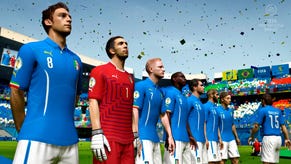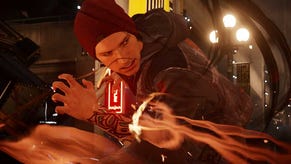FIFA 14: more power, more precision
EA Canada is keen to unlock the potential of the beautiful game in FIFA 14. Nick gets his paws on what's likely to be one of the hottest tickets of the next-gen transition.
I have never been so excited to see Gareth Bale’s defined pecs.
EA Canada implemented such details into FIFA 13 with a January patch, but this time, the Welshman’s bulging man muscles represent the type of player who will shine across FIFA 14’s many updates. This is no longer a game of speed, “sweaty goals” and defensive slackness, but rather, a tale of triumphant team efforts.
Following the recent success of German juggernauts Bayern Munich, FIFA 14 prioritises the same values as Jupp Heynckes’ Champions League winning team: tactical strategy, power, possession and a couple of bombing wingers who can skip beyond opponents. Perhaps most importantly, EA’s decision to implement ‘Precision Movement’ goes a long way to ensure extreme pace and superhuman agility is solely left to the elite.
“It’s a new locomotion system that we’ve been building for two years, and it’s a new animation system,” FIFA 14 gameplay producer Kantcho Doskov told me.
“It allows us to create more accurate biomechanical movement. Initially in FIFA we had canned animations for locomotion, which looked good. They were mo-capped clips that players would use to turn and pivot. They looked great but the responsiveness was really, really low as you had to finish the entire animation and then go to another one.
“Over the years we improved that by blending locomotion animations. That helped responsiveness—you could move wherever you wanted—but it just didn’t look as good because the player would slide and float a little on the field. It just didn’t look or feel good in terms of player movement.”
Although FIFA 13’s animation allows an exciting game to be played, last year’s title essentially throws 22 faultless players onto the pitch. The ball doesn’t react to their momentum, as anything apart from perfect control doesn’t exist, bar the referee occasionally blocking your route. This pattern is broken up in FIFA 14, as every individual step is now taken into consideration alongside the events of each match.
“[When playing the game] If I want to go forward, I can take one step forward then change my mind and make a turn,” Doskov explains.
“We’re preserving the momentum I started off with, so if I’m sprinting, it’ll take a few steps to slow down and then I’m allowed to change direction. If I was jogging at a slower speed, I would take maybe one or two steps rather than three of four if I was sprinting.
“What this amounts to in the end is a more realistic simulation style of gameplay which is based on real player movement and biomechanics. It takes into account the acceleration and deceleration of real players without allowing them to stop on a dime.”
"What this amounts to in the end is a more realistic simulation style of gameplay which is based on real player movement and biomechanics."
Such changes are immediately apparent when trying FIFA 14 for the first time. Playing as Paris Saint-Germain, it’s clear that rapid attackers such as Jeremy Menez and Lucas Moura are no longer going to find consistent success through an explosion of pace. While their speed is certainly noticeable alongside other players, the once elusive forwards bounce away from the opposition like insults off Rafa Benitez’s back. The ball is no longer coated in PVA and bumbles away from possession whenever I disregard the physical impact of momentum.
Suddenly, key strengths from each member of the team take on greater importance. Marco Verratti’s ability to break legs helps retain possession, while Zlatan Ibrahimovic’s physicality holds off the imposing threat of defenders. Thiago Silva looms over the pacey attackers of Barcelona’s Lionel Messi and Alexis Sanchez, halting the stylish duo with a sense that his body really exists and has been designed alongside real-world attributes.
Playing a fellow journalist as Borussia Dortmund, the short-sharp passing of Sven Bender and Ilkay Gundogan quickly emerges as the best method of attack. FIFA 14 is not about punting the ball up field in hope of latching onto possession, but rather stringing together methodical passes that slowly pry gaps open. This transition is vital and allows EA Canada to address defensive failures of the previous year.
“The main feature we’ve had feedback on [from FIFA 13], even amongst ourselves, is the defensive AI. We’ve made a lot of improvements to the AI and the offensive runs that were made last year, as unfortunately, the defensive AI couldn’t always handle that,” reveals Doskov.
“They would stop tracking their mark or would pass them onto another defender, but that defender would stick with their mark. Things like this would lead to players breaking through on goal and being unmarked, leading to a lot of goals the community would call ‘sweaty goals.’ Your defender didn’t track back as well as he should have. This was one of the huge pieces of feedback we received from the community and it’s something we spent a lot of time on this year.”
“We’re calling it the ‘Teammate Intelligence Feature’. It’s a bunch of improvements in our AI for defensive players: how they analyse who they need to mark, how they switch their marking assignment from one player to another and when they decide to stay with him or pass him onto a defender who is in a better position.”
“We’ve also tightened up the marking overall, so now players will stay a lot closer rather than backing off. All of those improvements are key for us this year, as last year we didn’t match what we did on the attacking side.”
No longer will the five star skills of Lee Trundle be comparable to Brazilian wonderkid Neymar, even if they both possess a love for questionable hair.
Whether you played as Barcelona or Barnet in FIFA 13, each player dribbled with the precision of someone who has won four Ballon d’Ors. Even for world-class dribblers, spamming sprint and sharply changing direction will not maintain success across 90 minutes in FIFA 14. No longer will the five star skills of Lee Trundle be comparable to Brazilian wonderkid Neymar, even if they both possess a love for questionable hair.
“You can be a team full of 90-rated pace players, but if their dribbling attributes are low, even lower than 80s or 70s, you’re going to notice the effect of error,” says Doskov.
“So it’s not going to be perfect like a player such as Messi, whose got 90+ dribbling and will be able to sprint at full pace while keeping close control. A player like Theo Walcott won’t be able to do that. You won’t be able to just build a team full of pace players and expect to be as effective as you were last year because the ball will get away.”
Much like Wayne Rooney’s positional change at Manchester United, I notice my overworked team are puffing well before each game finishes. Holding the sprint button may be natural to FIFA 13 players, but in FIFA 14, it’s a guaranteed way of throwing away three points. Rooney may be an energetic bulldozer in midfield, but those excess burgers quickly catch up if you continuously crash about the pitch at full pace.
“We’ve rebalanced our fatigue model this year, to retune it in certain cases where sometimes we were effecting certain attributes where we shouldn’t have,” explains Doskov.
“For example: ball control was affected too much in FIFA 13 based on the player’s fatigue. So a player like Xavi—someone who is rated around 95 for ball play—if in the 90th minute his fatigue was low, his attributes get decreased too significantly. That’s something we’ve resolved this year.”
Even at this early stage, such changes significantly alter the way FIFA 14 plays compared to its predecessors. It now represents the meticulous nature of Bayern Munich and Dortmund; teams that take defensive duties and the retention of possession as seriously as scoring outrageous goals.
As Doskov suggests, this method further establishes FIFA 14 away from Konami’s Pro Evolution Soccer series.
“We don’t really want to have that type of gameplay, that arcadey gameplay. For FIFA we want more of a simulation game which builds up play with passing through the midfield. That’s what we want to achieve, something more realistic and like real football.”




















